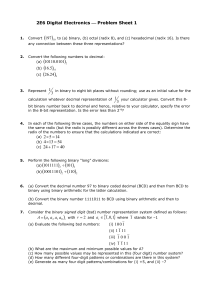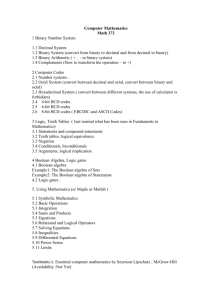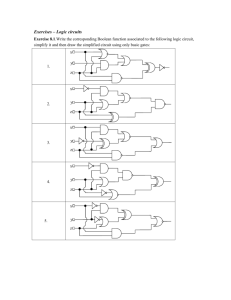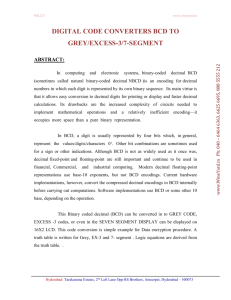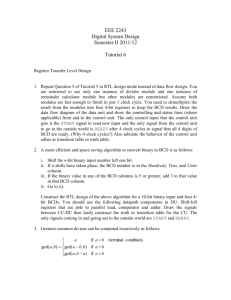A High Performance Binary to BCD Converter
advertisement
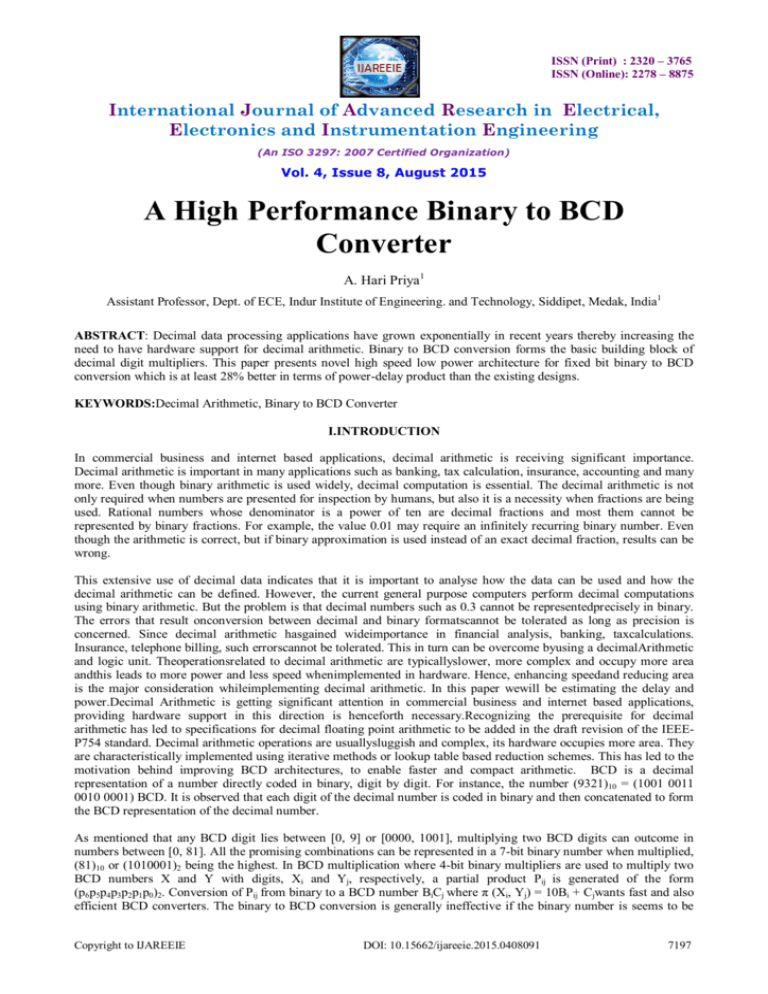
ISSN (Print) : 2320 – 3765
ISSN (Online): 2278 – 8875
International Journal of Advanced Research in Electrical,
Electronics and Instrumentation Engineering
(An ISO 3297: 2007 Certified Organization)
Vol. 4, Issue 8, August 2015
A High Performance Binary to BCD
Converter
A. Hari Priya1
Assistant Professor, Dept. of ECE, Indur Institute of Engineering. and Technology, Siddipet, Medak, India1
ABSTRACT: Decimal data processing applications have grown exponentially in recent years thereby increasing the
need to have hardware support for decimal arithmetic. Binary to BCD conversion forms the basic building block of
decimal digit multipliers. This paper presents novel high speed low power architecture for fixed bit binary to BCD
conversion which is at least 28% better in terms of power-delay product than the existing designs.
KEYWORDS:Decimal Arithmetic, Binary to BCD Converter
I.INTRODUCTION
In commercial business and internet based applications, decimal arithmetic is receiving significant importance.
Decimal arithmetic is important in many applications such as banking, tax calculation, insurance, accounting and many
more. Even though binary arithmetic is used widely, decimal computation is essential. The decimal arithmetic is not
only required when numbers are presented for inspection by humans, but also it is a necessity when fractions are being
used. Rational numbers whose denominator is a power of ten are decimal fractions and most them cannot be
represented by binary fractions. For example, the value 0.01 may require an infinitely recurring binary number. Even
though the arithmetic is correct, but if binary approximation is used instead of an exact decimal fraction, results can be
wrong.
This extensive use of decimal data indicates that it is important to analyse how the data can be used and how the
decimal arithmetic can be defined. However, the current general purpose computers perform decimal computations
using binary arithmetic. But the problem is that decimal numbers such as 0.3 cannot be representedprecisely in binary.
The errors that result onconversion between decimal and binary formatscannot be tolerated as long as precision is
concerned. Since decimal arithmetic hasgained wideimportance in financial analysis, banking, taxcalculations.
Insurance, telephone billing, such errorscannot be tolerated. This in turn can be overcome byusing a decimalArithmetic
and logic unit. Theoperationsrelated to decimal arithmetic are typicallyslower, more complex and occupy more area
andthis leads to more power and less speed whenimplemented in hardware. Hence, enhancing speedand reducing area
is the major consideration whileimplementing decimal arithmetic. In this paper wewill be estimating the delay and
power.Decimal Arithmetic is getting significant attention in commercial business and internet based applications,
providing hardware support in this direction is henceforth necessary.Recognizing the prerequisite for decimal
arithmetic has led to specifications for decimal floating point arithmetic to be added in the draft revision of the IEEEP754 standard. Decimal arithmetic operations are usuallysluggish and complex, its hardware occupies more area. They
are characteristically implemented using iterative methods or lookup table based reduction schemes. This has led to the
motivation behind improving BCD architectures, to enable faster and compact arithmetic. BCD is a decimal
representation of a number directly coded in binary, digit by digit. For instance, the number (9321)10 = (1001 0011
0010 0001) BCD. It is observed that each digit of the decimal number is coded in binary and then concatenated to form
the BCD representation of the decimal number.
As mentioned that any BCD digit lies between [0, 9] or [0000, 1001], multiplying two BCD digits can outcome in
numbers between [0, 81]. All the promising combinations can be represented in a 7-bit binary number when multiplied,
(81)10 or (1010001)2 being the highest. In BCD multiplication where 4-bit binary multipliers are used to multiply two
BCD numbers X and Y with digits, Xi and Yj, respectively, a partial product Pij is generated of the form
(p6p5p4p3p2p1p0)2. Conversion of Pij from binary to a BCD number BiCj where π (Xi, Yj) = 10Bi + Cjwants fast and also
efficient BCD converters. The binary to BCD conversion is generally ineffective if the binary number is seems to be
Copyright to IJAREEIE
DOI: 10.15662/ijareeie.2015.0408091
7197
ISSN (Print) : 2320 – 3765
ISSN (Online): 2278 – 8875
International Journal of Advanced Research in Electrical,
Electronics and Instrumentation Engineering
(An ISO 3297: 2007 Certified Organization)
Vol. 4, Issue 8, August 2015
very large enough. Hence the conversion can be ended in parallel for each partial product after each BCD digit is
multiplied as shown in Figure.1 and the resulting BCD numbers after conversion can be added using BCD adders.
Additional alternativewould be to compress the partial products of all binary terms in parallel and then convert them to
BCD as done.
In this paper we introduce a new architecture for binary to BCD conversion of partial products which forms the core of
decimal multiplication algorithms such as [7] and [8].
Figure 1: Illustration of BCD conversion in BCD
II.LITERATURE SURVEY
As pronounced in [1] BCD-digit multiplier can assist as the key building block of a decimal multiplier, regardless of
the degree of parallelism. A BCD-digit multiplier creates a two-BCD digit product from two input BCD digits. We
provide a novel design for the concluding;viewing some benefits in BCD multiplier implementations.
As described in [2] describes several methods of performing fast, efficient, binary-to-decimal conversion. With a
modest amount of circuitry, an order of magnitude speed enhancement is achieved. This attainmentdeals a
matchlessbenefit to general-purpose computers needing special hardware to interpret between binary and decimal
numbering systems.
As described in [3], Couleur described a serial binary/ decimal conversion algorithm, the BIDEC method. It was a twostep methodconnecting a shift shadowed by a parallel modification of the data being converted. Now with the
assistance of the integrated-circuit J-K flip-flop, the implementation of this two-step process needs an extreme amount
of control logic. This paper presents a one-step conversion algorithm that is appropriate for binary-to-decimal and
decimal-to-binary conversion. Anall-purpose design procedure for expressing the conversion registers as a presentstate/next-state counter problem is given, along with numeroussamples of the application of the one-step algorithm.
The advantages of this novel algorithm include low cost, faster operation, and also hardware modularity.
As described in [4] the risingappreciation of decimal computer arithmetic in scientific, commercial, financial and
Internet-based applications, the only hardware realization of decimal arithmetic algorithms is in advance more
importance. Thus Hardware decimal arithmetic units now help as an essential part of some newly commercialized
general purpose processors, on the other hand complex decimal arithmetic operations, such as multiplication, have been
recognized by somewhat slow iterative hardware algorithms. Nevertheless, with the fastimprovements in very large
scale integration (VLSI) technology, semi- and fully parallel hardware decimal multiplication units are predictable to
changeshortly. The foremost representation for decimal digits is the binary-coded decimal (BCD) encoding. The BCDdigit multiplier can help as the significant building block of a decimal multiplier, regardless of the degree of
parallelism. A BCD-digit multiplier yields a two-BCD digit product from two input BCD digits. We make available a
novel design for the former, showing some benefits in BCD multiplier implementations.
Copyright to IJAREEIE
DOI: 10.15662/ijareeie.2015.0408091
7198
ISSN (Print) : 2320 – 3765
ISSN (Online): 2278 – 8875
International Journal of Advanced Research in Electrical,
Electronics and Instrumentation Engineering
(An ISO 3297: 2007 Certified Organization)
Vol. 4, Issue 8, August 2015
As defined in [5] the, decimal multiplication is avital part ofthe financial, commercial, as well as internet-based
computations. Here elementary building block of a decimal multiplier is a single digit multiplier. It takes two Binary
Coded Decimal (BCD) inputs and provides a product that is in the range of [0, 81] characterized by only two BCD
digits. A unique design for single digit decimal multiplication that role is toreduce the critical path delay and area is
proposed in this investigation. On view of the among possible 256 combinations for the 8-bit input, only hundred
combinations of them are seem to be valid BCD inputs. In the hundred valid combinations only four combinations need
4 times 4 multiplication, 64 combinations need 3 times 3 multiplication, and the remaining 32 combinations use either
3 times 4 or 4 times 3 multiplication. The proposed design makes use of this property. This design leads to more
regular VLSI implementation, and does not have need of special registers for putting away easy multiples. So it is a
fully parallel multiplier consuming only combinational logic, and is extended to a Hex/Decimal multiplier that provides
either a decimal output or a binary output. The gathering of partial products produced using single digit multipliers is
done by an array of multi-operand BCD adders for an (n-digit time’s n-digit) multiplication.
III.PROPOSED ALGORITHM
As we discussed earlier the main motto of the proposed algorithm in the paper is to achieve the more effective fixed bit
binary to BCD conversion have been considered by relating with power,, delay and area.as discussed in earlier work
most of author worked on 7-bit binary to 8-bit/2-digit BCD converters, so we designed our proposed algorithm keeping
in the mind above considerations to have extra benefit with the converters. Here we treated p6p5p4p3p2p1p0 be seven
binary bits that are to be converted into corresponding two parts; among them first one comprises the lower significant
bits (LSBs) p3, p2, p1 and p0 while the second part contains the remaining higher significant bits (HSBs) p6, p5 and
p4.Here (LSBs) has the similar weight as that of a BCD digit and that could be directly used to denote a BCD digit.
Therefore only exclusion attains when p3p2p1p0 exceeds (1001)2 or (9)10. So finally we convert the LSBs into a valid
BCD number we check whether p3p2p1p0 exceeds (1001)2, and if it see to, we then add (0110)2 to it.
So now we define this kind of adding (0110)2 whenever the particular number exceeds (1001)2 is named correction in
BCD arithmetic. So obtained carry from this process is added immediately to the higher significant BCD digit
calculated from the HSBs of the original binary number. Generally HSBs not only helps to the particular higher
significant BCD digit rather to the lower significant BCD digit also. So these kind of major contributions of HSBs
towards the lower significant digit are added subsequently BCD correction. The obtained resulting sum is then checked
for the instance (1001)2 and correction is done only if wanted to get the final lower significant BCD digit.
At this timeobtained carry from the above process is added sonly to the higher significant digit causing in the final
higher significant BCD digit. We also gets the case when two BCD digits are multiplied only six combinations of p6, p5
and p4 (HSBs) are possible, that are likely to be 000, 001, 010, 011, 100 and 101. At this situation each of these
combinations have a different involvement towards the lower and higher significant BCD digits. So finally we can say
that influence can be easily calculated by assessing the weights of the patterns which are p6x27 + p5x26+ p4x25.
Contribution of each of these patterns towards the lower and higher BCD digits is shown in table.
Table 2: Contribution of HSBs
Higher Significant
Bits (HSBs
Higher Significant
BCD Digit
Lower Significant
BCD Digit
000
001
0000
0001
0000
0110
010
011
100
101
0011
0100
0110
1000
0010
1000
0100
0000
Copyright to IJAREEIE
DOI: 10.15662/ijareeie.2015.0408091
7199
ISSN (Print) : 2320 – 3765
ISSN (Online): 2278 – 8875
International Journal of Advanced Research in Electrical,
Electronics and Instrumentation Engineering
(An ISO 3297: 2007 Certified Organization)
Vol. 4, Issue 8, August 2015
The below figure clearly shows an example of the algorithm for number (111111)2or (63)10 or (0110 0011) BCD.
By above discussions the maximum utilization of the process is limited and small numbers of consequences are feasible
for conversion has been done while designing the given architecture to reduce delay, power as well as area. Figure.3
shows the proposed architecture.
Figure 2: Proposed Algorithm for BCD conversion
Figure 3: Proposed Architecture
Copyright to IJAREEIE
DOI: 10.15662/ijareeie.2015.0408091
7200
ISSN (Print) : 2320 – 3765
ISSN (Online): 2278 – 8875
International Journal of Advanced Research in Electrical,
Electronics and Instrumentation Engineering
(An ISO 3297: 2007 Certified Organization)
Vol. 4, Issue 8, August 2015
p6p5p4p3p2p1p0 are the binary bits that have toconvert into corresponding BCDbitsz7z6z5z4 z3z2z1z0. At the same time p6,
p5 and p4 are the HSBs while p3, p2, p1 and p0 are the LSBs. z0 is same as p0 and hence therefore no operation is
performed on p0. {p3, p2 and p1} are used to check whether the present LSBs are greater than (1001)2 or not using
equation (1) and are directed to the BCD Correction block.
C1 = p3. (p2 + p1) ………………… (1)
Whenever C1 is high, BCD Correction block immediately adds 011 to the input bits. Figure.4 shows the
implementation of BCD Correction block.
Figure.4: BCD Correction
In analogous, HSBs beside with p3 are fed to a given simple logic block recognized as Contribution Generator which
yields the higher significant BCD digits. The logic implemented by the ContributionGenerator is as follows
t3 = p6p4 ……………….
(2)
t2 = p5 (p4+p3) + p6p4……………….. (3)
t1 = (p5+p6) p4………………4)
t0 = p6‟p5‟p4 + p5p4………………….. (5)
C1 is the carry from the lower significant digit, so it is added to the higher significant digit t3t2t1t0. It is observed that
very few cases lead to the propagation of the incoming carry from t1 to t2. Hence, we take benefit of this situation and
also device {t3, t2} in combinational logic thus eliminating the need to add C1 to these terms, thus saving hardware and
complexity thus 2-bit One Adder, as presented in Figure.5,
that is used to add C1 to t0 and t1.
Now there is anoption of a carry generation, when the contributions of HSBs are added to the corrected LSBs (a3, a2
and a1). This carry is calculated ahead of time by a Carry Generator block using C1 and input bits p6 to p1. The logic
implemented by Carry Generator is given by the equation below
C2 = C1 (p4 (p3+p2) +p3p5) + p6p3 + p4p3p1………………… (6)
Figure.5 : 2-bit One Adder
Copyright to IJAREEIE
DOI: 10.15662/ijareeie.2015.0408091
7201
ISSN (Print) : 2320 – 3765
ISSN (Online): 2278 – 8875
International Journal of Advanced Research in Electrical,
Electronics and Instrumentation Engineering
(An ISO 3297: 2007 Certified Organization)
Vol. 4, Issue 8, August 2015
C2 is similarly added to result of the principal 2-bit One Adder using alternative 2-bit One Adder and the final higher
significant digit is Higher Significant obtained. {t3 and t2} are equivalent to z7 and z6 respectively and are
directlyaccessible from the above Contribution Generator block.
Now contribution of HSBs towards lower significantBCD digit is static and distinctive and is known once HSBs are
known. We have implemented four distinct adder units which add only stated values to the inputs in parallel according
to the contributions in Table. On the other hand different adder blocks, +1, +2, +3 and +4 (shown in Figure.6) add 001,
010, 011 and 100 to the input bits correspondingly. So the Adder blocks take the corrected LSBs (a3, a2, a1) as inputs
and add particular numbers to them. The suitable result is then acquired through a multiplexer whose selection bits are
p6, p5 and p4 (HSBs). Then finally result from the multiplexer is then fed to BCDCorrection block which takes C2 as
input then decides whether correction has to be done or not. Now the results obtained from the BCD Correction block
are z3, z2 and z1 which, along with z0, form the final lower significant BCD digit.
Figure.6: +1, +2, +3, +4 adder blocks
IV . RESULT AND DISCUSSION
The results of the above method have been simulated with the help ofXilinxtool and analysed it and implemented its
RTL Schematic using corresponding part number and shows that with the specialized converter overwhelming features
that led better conversion in case of area, power and delay.
Copyright to IJAREEIE
DOI: 10.15662/ijareeie.2015.0408091
7202
ISSN (Print) : 2320 – 3765
ISSN (Online): 2278 – 8875
International Journal of Advanced Research in Electrical,
Electronics and Instrumentation Engineering
(An ISO 3297: 2007 Certified Organization)
Vol. 4, Issue 8, August 2015
RTL Schematic:
Internal Schematic:
Simulation:
Copyright to IJAREEIE
DOI: 10.15662/ijareeie.2015.0408091
7203
ISSN (Print) : 2320 – 3765
ISSN (Online): 2278 – 8875
International Journal of Advanced Research in Electrical,
Electronics and Instrumentation Engineering
(An ISO 3297: 2007 Certified Organization)
Vol. 4, Issue 8, August 2015
VI.CONCLUSION
We discussed that the architectures have been designated using Verilog HDL.Corresponding Delay, power and area
values for the designs are acquired by synthesizing the Verilog HDL description language. The proposed converter is
very flexible that can be easily plugged into any homogeneous multiplication architectures to accomplish better
performance regardless of the method employed to generate binary partial products.
REFERENCES
1.
2.
3.
4.
5.
6.
7.
8.
Arazi, B., and Naccache, D.: „Binary-to-decimal conversion based on the 28 2 1 by 5‟, Electron. Let, 1992.
Schmookler, M.: „High-speed binary-to-decimal conversion‟, IEEE Trans. Comput., 1968.
Rhyne, V.T.: „Serial binary-to-decimal and decimal-to-binary conversion‟, IEEE Trans. Comput., 1990.
Binary-coded decimal digit multipliers Jaberipur, G.; Kaivani A. Computers and Digital Techniques, IET Volume 1, Issue 4, July 2007.H.
Khalife, N. Malouch, S. Fdida, “Multihop cognitive radio networks: to route or not to route,” IEEE Network, vol. 23, no. 4, pp. 20-25, 2009.
Decimal multiplication using compact BCD multiplier James, R.K.; Shahana, T.K.; Jacob, K.P.; Sasi, S.; Electronic Design, 2008. ICED 2008.
International Conference on 1-3 Dec. 2008.
Decimal multiplication using compact BCD multiplier James, R.K.; Shahana, T.K.; Jacob, K.P.; Sasi, S.; Electronic Design, 2008. ICED 2008.
International Conference on 1-3 Dec. 2008 Page(s):1 – 6.
Binary-coded decimal digit multipliers Jaberipur, G.; Kaivani, A. Computers and Digital Techniques, IET Volume 1, Issue 4, July 2007
Page(s):377 - 381.
Novel High-Speed Architecture for 32-Bit Binary Coded Decimal (BCD) Multiplier Veeramachaneni, S.; Srinivas, M.B. Communications and
Information Technologies, 2008. ISCIT 2008. International Symposium on 21-23 Oct. 2008 Page(s):543 – 546.
BIOGRAPHY
A. Hari PriyareceivedBTech (ECE) in Malla Reddy College of Engineering and Techin
Maisammaguda, Dhulapally, Kompally, Medchal in the year 2009. And MTech (VLSI
System Design) in Hyderabad Instituteof
Tech. and Mangement at
Gowdevally (v), Medchal (M), in the year 2011. She is currently working as Assistant
Professor, Dept. of ECE, Indur Institute of Engineering. And Technology, Siddipet, Medak
(D) India.
Copyright to IJAREEIE
DOI: 10.15662/ijareeie.2015.0408091
7204
